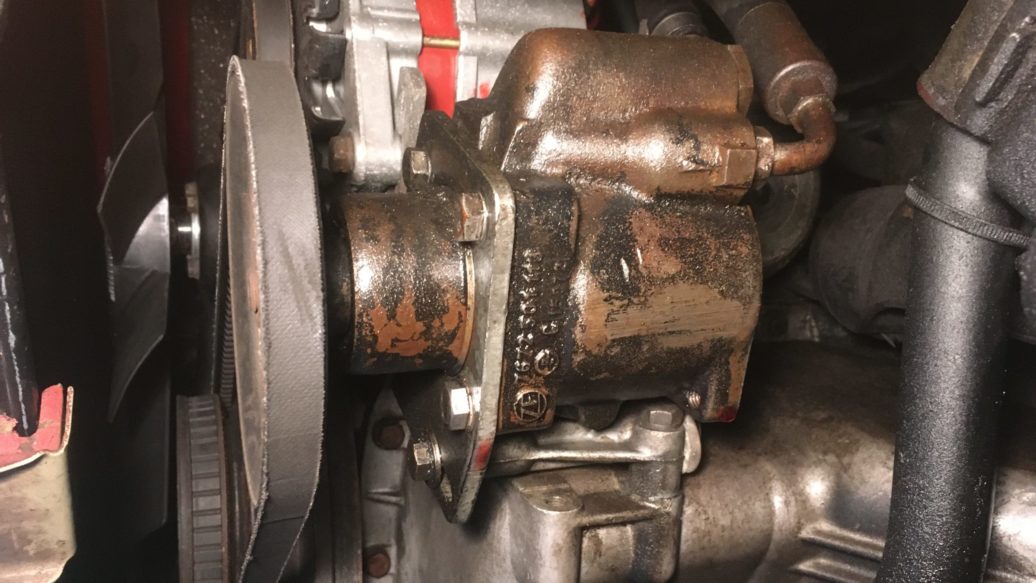A few weeks ago, I wrote about taking Rene, my 1973 E9 3.0CSi, on a mini road trip to Vintage at Saratoga in upstate New York, with a side trip through Vermont on the way home. Everything went swimmingly, with the exception of a long-term steering issue that rocketed to the front burner.
For the entire 35 years I’ve owned the car, the steering hasn’t felt right. It’s never steered as smoothly and stayed on-center as well as my Bavaria, or any of my other vintage BMWs for that matter. The worst part is that it feels darty on narrow, steeply-crowned roads, as ambiguous as Marty Feldman’s stare. And when I left Vintage at Saratoga and headed east over the mountains to Manchester Vermont, nearly the entire drive was on narrow, steeply-crowned roads, pushing the problem right in my face.
As I wrote in the prior piece, before the trip, I checked the car and found zero play in the steering box, tie rods, center track rods, or idler bushings, but there appeared to be four other separate issues that could contribute to the odd-feeling steering:
- The power steering has long had issues. There is the kind of groan from the power steering pump you often hear in older cars, but in addition, I thought that I could almost feel the power steering engage and disengage when I turned the steering wheel while driving, and the fluid in the reservoir didn’t appear to be moving as much as I would’ve expected. I pulled out the odd hard-as-bone cylindrical filter from the reservoir, ran the engine for a while, put the filter back in, and fluid motion seemed to increase, but the groan and odd steering feel were both still there, particularly during local driving.
- I found that the right front tire was worn on the inside edge. It wasn’t badly scalloped, but a tread depth measurement showed that the innermost tread groove had 5/32″ of depth, whereas the rest of the tire had 7/32″ or 8/32″.
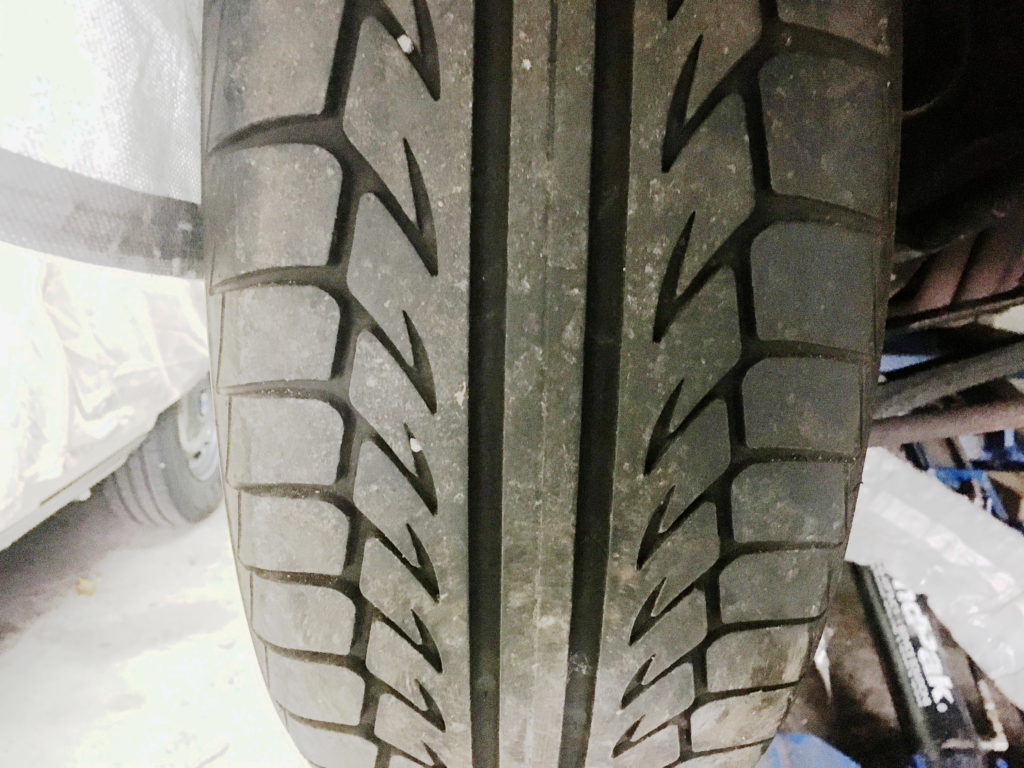
You can sort of make out that the inside (right) edge is more worn than the outside.
- As I wrote about here, I do my own alignments using a pointer bar (also called a trammel bar). I took measurements behind and in front of the E9’s front tires, and they showed that there was a whopping 3/8″ of toe-out. I thought “Gotcha! No wonder the thing felt darty!” I set the toe-in to zero, and although it felt better on the highway, unfortunately it had no effect on the feeling of darty-ness on narrow, steeply-crowned roads.
- The rubber bushing where the driver’s side lower control arm is through-bolted to the front subframe had a chunk hanging from it, though there was no apparent play in the arm. I didn’t think this was a root cause of the problem, but I try not to reject things out of hand, as that creates blind spots in troubleshooting.
Since the power steering was still groaning, it seemed to be the obvious place to zero in. Groaning steering can be caused either by a bad power steering pump, or by air bubbles in the power steering fluid, which in turn can be due to the system not having been correctly bled (generally accomplished by turning the steering wheel lock-to-lock multiple times) or because air is being drawn into the system from a leak in the suction line. I performed a cursory bleeding, and it made no difference. I had the bright idea that I should try disconnecting the pump—meaning taking the belt off it—to see if the car’s handling still felt darty with no power assist at all, but the power steering belt sits behind the belt for the a/c compressor, and unfortunately, the configuration I have with the Sanden 508 compressor and its bracket make it so I can’t easily loosen the compressor belt enough to remove it without actually unbolting the compressor from the bracket. Since I felt it was likely that the pump had reached the end of the line, rather than make extra work for myself, I thought I’d find another power steering pump so I could swap the pump and leave the a/c compressor and its belt alone.

You… shall… not… PASS!
Unfortunately, buying another power steering pump was more involved than I expected. E3s and E9s use an early ZF power steering pump. Looking on RealOEM, I could see that the pump has been superseded several times. The M30 engine block was used in BMWs from 1968 through to the mid-1990s and hosted several different power steering pumps, but I didn’t remember what the issues were in getting a later pump, say from an E28, to fit in an early 1970’s car. The thing is, the engine in Rene is actually an M30B32 that came from a 1983 E28 533i. I did remember that when I put the engine in the car over 30 years ago, there was a bit of trail and error involved with fitting ancillary block components, and in the end it was mix-and-match. So I crawled under Rene’s nose and looked at the power steering pump and verified that it was in fact the original style, which meant that, 30 years ago, I likely tried the E28 power steering pump that came on the engine and discovered that it had a clearance issue with other components I was fitting. I looked on eBay and saw that sellers were asking between $450 and $750 for used (not rebuilt) early E3/E9 power steering pumps. I could’ve sent mine out and had it rebuilt, but even though I’m not depending on the E9 being available at the drop of a hat, I really preferred not to take it “down” and instead wanted a replacement pump in hand before removing the original one. I briefly thought about swapping in the one from the Bavaria, but this is more involved than just, say, swapping an alternator. Removing and installing one pump is a messy enough job without making work for myself by dragging another car into it. Plus, the Bavaria is out in Fitchburg.
I found a newer-style higher pressure (100 bar) pump from an early 633CSi on eBay for a hundred bucks. I looked on e9coupe.com and saw references to people using these in their E9s. The auction listed the pump’s condition merely as “used” (that is, it didn’t say “known good”) and also stated that no returns would be accepted. Although that gave me pause, I searched a bit more and didn’t find any other inexpensive options, so I hit the Buy it Now button.
It took nearly two weeks for the pump to arrive, but once I had it in hand, I put Rene up on the mid-rise lift, drained the power steering fluid (which on this car is actually automatic transmission fluid), and removed the old pump. I could see that there were minor differences with the 633 pump—the mounting bracket from the old pump would need to be transferred over, and the hose fitting was routed differently—but these seemed manageable.
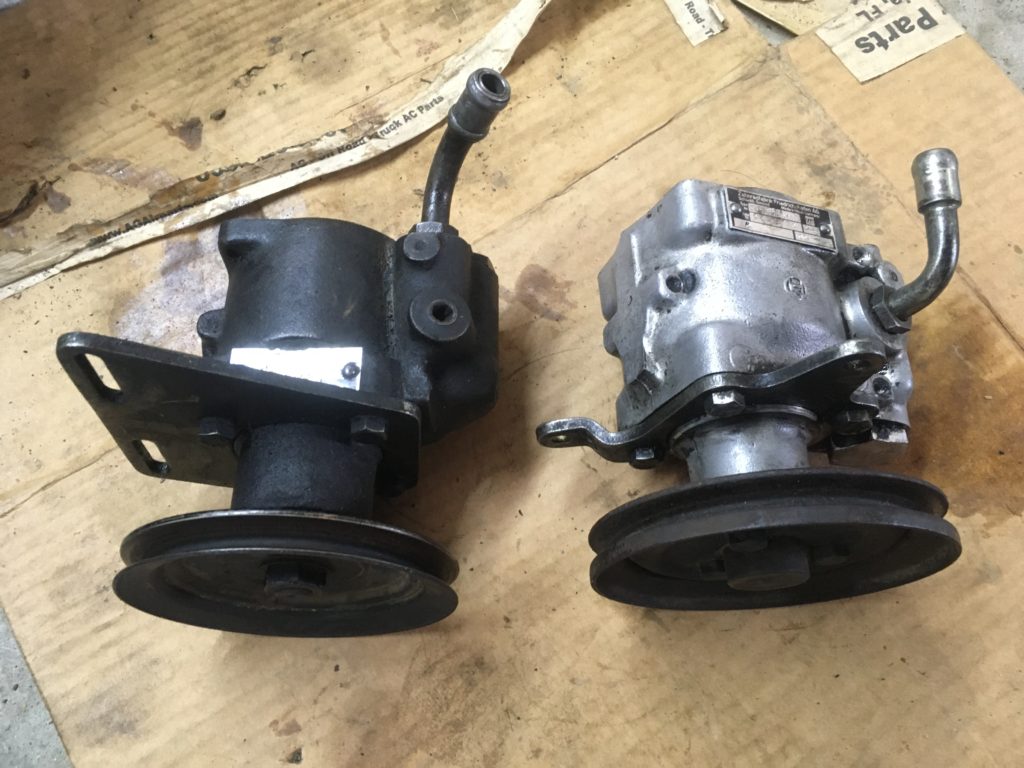
Original (left) and 633CSi pump (right).
However, when I picked up the replacement pump by the pulley, I heard a loud “THOCK.” I found that the pump had an alarming amount of fore-aft play in the shaft. My old pump had no such play. This is demonstrated in this video.
I contacted the eBay seller, sent him the video, and explained that, in my opinion, the axial play was bad enough that the pump really should’ve been listed as “for repair or parts” instead of “used.” I asked him to take it back and refund my money even though it was a no-return auction, but said that understood the risk of a used part and a no-return auction and thus I’d be happy to pay the shipping to send it back to him. He responded almost immediately, refunded my money, and told me I could keep the pump, maybe use it for parts or get it rebuilt. What a class act.
With the original power steering pump already removed from the car and its belt just hanging, still trapped by the compressor belt, clearly the thing to do was try my idea of driving the car without power steering. I again tried to disconnect the a/c compressor belt that was blocking the power steering belt’s removal, and this time was able to nudge it off the crankshaft pulley without completely unbolting the compressor.
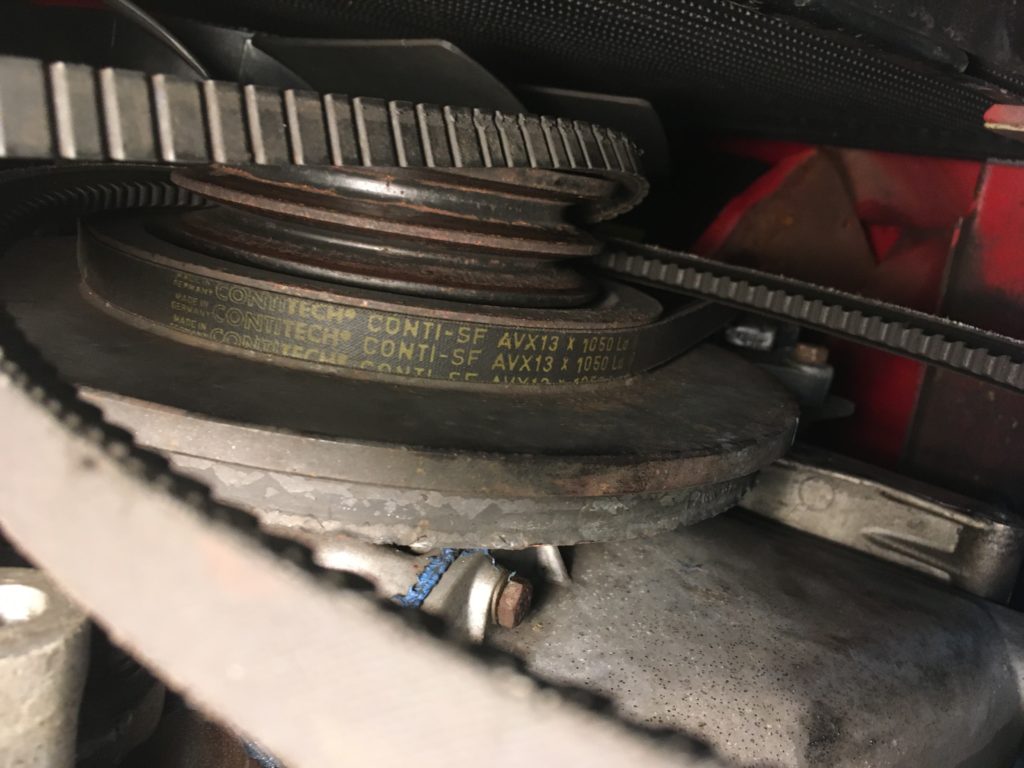
Juuust enough clearance to slip the compressor belt off.
I drove the car with non-power-assisted steering, and although it certainly had a different feel, to my stunned surprise, it did not eliminate the darty feeling on steeply-crowned small roads. This was not at all what I expected, but at least it meant that I could eliminate the power steering pump as the cause. I’ll see if a new filter, fresh fluid, and a thorough bleeding will make it stop groaning.
I did a bit of web research on what else might cause darty steering, and something surprising came up—camber (the tilt of the wheels relative to the vertical axis). If you don’t know, zero camber means that the wheels are perfectly vertical. Negative camber, like you see on overly “stanced” cars, means that the tops of the wheels are tipped in toward the center of the car to improve handling by making the tire’s contact patch lie flat on the asphalt when the car is under cornering load. There’s a widely-held opinion that vintage BMWs can use additional front wheel camber (meaning additional negative camber), and camber plates mounted at the tops of the front struts can be employed to change the suspension geometry and provide either a fixed or adjustable amount of additional camber. However, as I said, according to some sources I read online, additional negative camber can have the effect of making the car feel darty.
This rang a bell deep in my memory. I recalled, years back, having an alignment done on the E9 at a highly reputable shop, and being handed the printout that showed that one of my front wheels had substantially more negative camber than the other, possibly due to the front end collision that the car was involved in before I bought it. I’m not great in terms of filing car receipts in their proper folders, but I opened up Rene’s folder, and, incredibly, there it was—alignment specs from November 20, 2007 (almost exactly fourteen years ago) showing that the right front wheel had substantially more negative camber than the left. Granted, there have been changes to the front end of the car since then—the sixteen-inch Alpina open lug wheels, the 205/55ZR16 tires, and cutting a coil off the springs to get it to sit where it doesn’t show so much ankle—but I’d expect these changes to affect camber symmetrically and leave the net imbalance in camber intact.
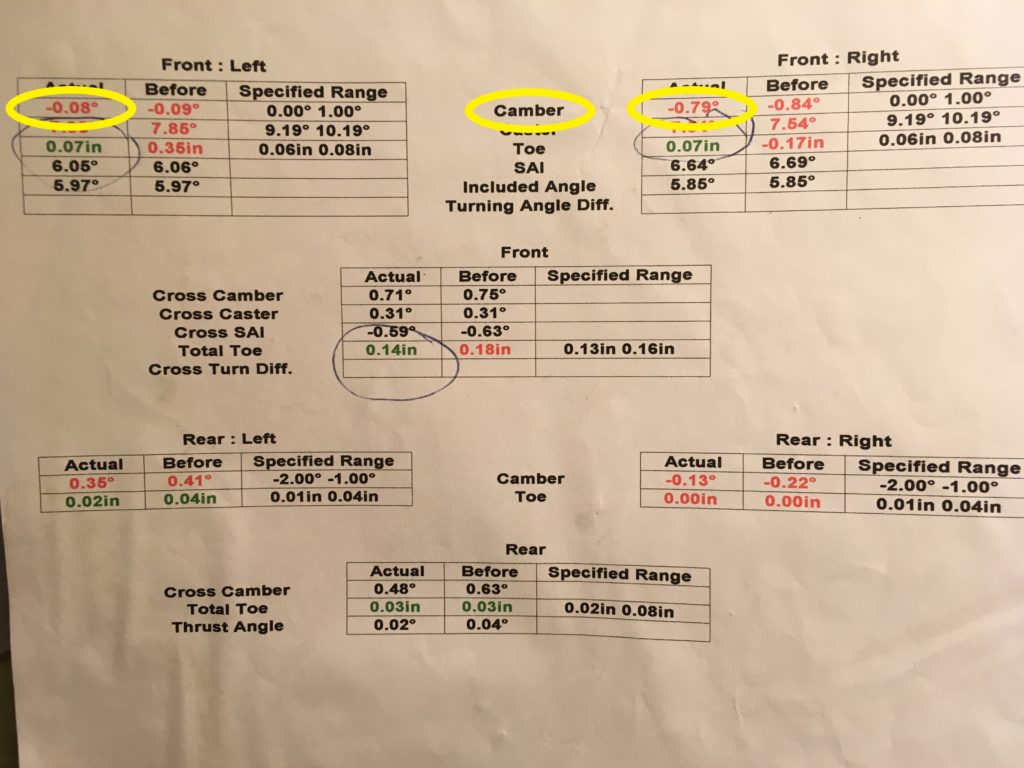
Wow.
And then, another bell went off—the wear in the tire. Which front tire was it that had the wear on the inside edge? I thought I knew the answer, but I went back out and inspected the car to be sure.
It’s the one on the right.
So, my working theory is that I have an issue of uneven front camber that is not only responsible for making the car feel darty on steeply-crowned roads, but left a smoking gun in the form of wear on the inside edge of the right front tire. I think that a camber gauge and a set of adjustable camber plates (and likely a professional alignment to dial it all in) is in my future. Unlike most people who buy adjustable camber plates, though, my goal isn’t necessarily more negative front camber to improve handling, but reasonable and even front camber to remove the darty feeling.
It would be incredibly satisfying to fix this long-standing problem with Rene. I’ll let you know how it works out.—Rob Siegel
Rob’s new book, The Best of The Hack Mechanic, is available here on Amazon, as are his seven other books. Signed copies can be ordered directly from Rob here.

